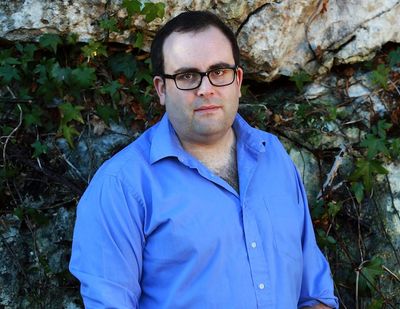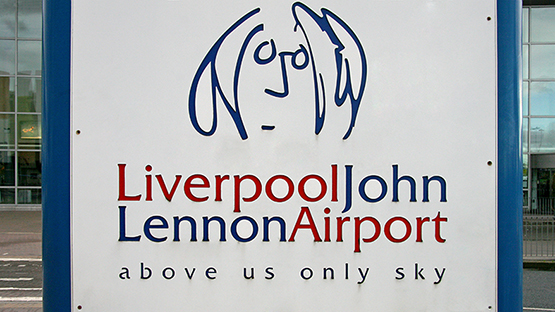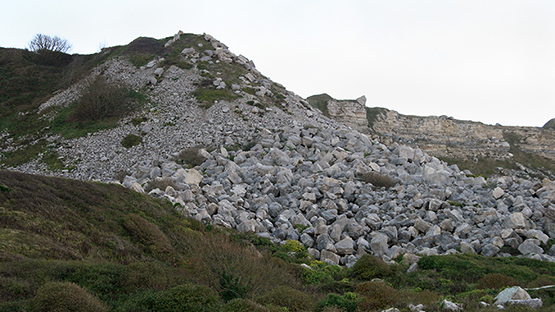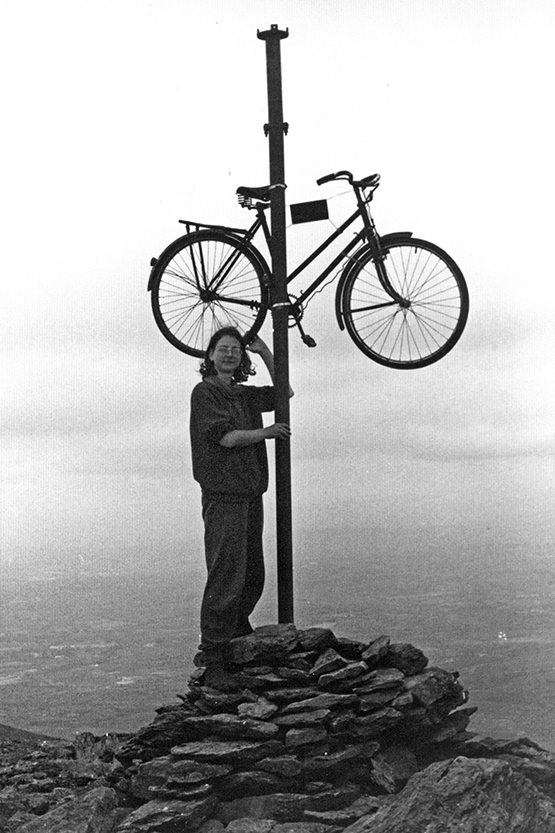Sean Lynch

Born in County Kerry, Ireland, and now based between London and Limerick, Sean Lynch studied sculpture at Limerick School of Art and Design before completing an MA in History of Art and Design at University of Limerick. However, it was crucial experiences while a student of Fine Art at HFBK Städelschule in Frankfurt am Main that more profoundly influenced his mature work. For Lynch, discovering Context Art and its continual manifestation in central Europe, and also arriving in Frankfurt at a time when heated discussions occurred there around the use of narrative form, meant that objects became containers of information, hearsay and rumour, to be opened up and liberally played with.
Lynch uses historical narratives as a point of departure to develop his artwork: for example the—now defunct—DeLorean Motor Factory, based near Belfast, which manufactured the classic car, provided the inspiration for one such artistic investigation (recently on view in London at the Ronchini Gallery). While Irish stonecarvers, who found their way to Oxford, provide the inspiration for an exploration of carving and sculpture in another. Manifesting as photographs, videos, sculpture and installations—in this case a video installation and a grouping of sculptures—here Lynch discusses the various projects that form the intellectual core of Adventure: Capital
, his contribution to the Irish Pavilion at this year’s Venice Biennale.
So Sean, are you enjoying setting up in Venice? How long has Ireland been participating in the Venice Biennale?
Initially, Ireland sent artists to Venice throughout the 1950s, led at that time by a progressive artistic community in Dublin keen to identify the state with the modalities of postwar modern art. They soon had a proposal—that now only exists as an anecdote—to symbolically unify Britain and Greece, countries then at odds over territorial lands in Cyprus. Irish builders would construct a national pavilion in a shape akin to the Bridge of Sighs, connecting the back of the British pavilion all the way over a canal to the Greek one. It would be the only building in the Giardini that wouldn’t touch the ground. Apparently, Britain and Greece were very happy for it to happen, and city authorities in Venice were delighted with this novel yet sincere gesture towards international diplomacy. The Irish government refused to fund it and soon after they stopped sending artists to Venice. Only in 1993 did a relationship with the Biennale begin again.
Now you’re not going to tell me that you’re going to build this bridge?
Ha, no no [laughs], Gerard Byrne has taken photographs of the space where the pavilion could have been. It’s a nice bit of history to share, like a ghost story of sorts.
Before we discuss your exhibition in Venice, can you tell me a bit about your work leading up to Venice?
Let me give you some background. I went to college at the Städelschule in Frankfurt in the mid 2000s. Many people from Hessen and Cologne bought cheap holiday home property around West Ireland in the 1970s and 80s. Some of this impetus came from Heinrich Böll’s writing on Ireland, read by millions in Germany since the 1950s, and the developing of a romantic image of the edge of Europe that had mass appeal. As a result, today there are incredibly well developed budget airline routes between small airports in the west of Ireland and central Europe. It was a kind of revelation to find I could get to Frankfurt faster than travelling cross-country to Dublin.
At that time in the Städel there was much debate around how narrative form and storytelling could function in relationship to photography, sculpture and exhibition formats. It seemed less about making stand-alone artworks, than about wriggling through allegorical modes in a process of making, leading on to find subjectivities an audience could be invited to share.
My last show was at Modern Art Oxford, about two Irish stone carving brothers called John and James O’Shea. They were born sometime in the early 19th century, location still unverified, and nobody knows where they acquired their accomplished stone carving skills. They survived the potato famine and later appeared as virtuoso artisans in Oxford in the late 1850s, where John Ruskin befriended them. He considered the O’Sheas as primordial ‘other’ energies from the edge of the empire, sent to help shape the Gothic Revival makeover of Britain. He gave public lectures extolling the fact they were thirty percent more economical than any other stone carver in Victorian England. John and James didn’t waste time making sketches or clay mockups, instead they would carve without any preparation, trusting their instincts. Each morning, they would visit the Botanic Gardens in Oxford and take a potted plant out for the day, bringing it up the scaffold, glancing at it and imposing those very same shapes directly into the stone.
This sounds almost like Michelangelo!
Their story is fairly archetypal in places, alright. I often consider Ernst Kris and Otto Kurz’s book Legend, Myth, and Magic in the Image of the Artist when thinking of the O’Sheas. They carved monkeys on the façade of the Oxford Museum, just as Darwin’s theories of human evolution were gaining momentum. When the University tried to censor these carvings, James O’Shea changed the monkeys into a grouping of fierce cats, referring to an old Irish myth about the Kingcat of Keshcorran, who guarded the entranceway into hell. They effectively labelled the creation of museological culture inside as a hellhole; it was institutional critique on an epic scale, a hundred years before the term even existed. Later, the O’Sheas ended up in more fights and covertly made more illicit carvings. You can still see all these features when walking down the street in Oxford today, yet they are frequently ignored and certainly not part of a wider discourse on individual agency, the public realm, and the accumulation of knowledge.
My relationship to this legacy was a two-year research project to build up a framework to valorise the O’Sheas’ achievements. There’s a 35mm slide show formed as an adhoc lecture of sorts, or a stone carving symposia, consisting of various talks, tours and a 150 page book that all take the O’Sheas’ methodology as a basis for how individual expression can challenge hegemonic belief systems.
Sean Lynch, A Blow by Blow Account of Stone Carving in Oxford, 2013-4. Courtesy Ronchini Gallery, London and Kevin Kavanagh Gallery, Dublin.
That’s a bit of work?
Don’t worry the book is readable, I think! [laughs] There’s biographical material and research notes, made during fieldwork in Oxford, alongside more tangential material: Lothar Baumgarten, fried chicken shops in London, and a study of 1970s conceptualism in Ireland feature in various roles. It was during this research that certain things became apparent for me about the nature of the roving spirit. Yes, there are artisans owning only the shirts on their back going round the landscape, carving on all the buildings rising up at the time. There’s all the romance of that, but also a kind of use value for our times, where a wandering approach can continue to skirt and undermine hierarchy, and authoritarian overture.
It’s a modality that I’ve been interested in for a while, and find it useful to locate examples that have a resonance. In 1983, Seamus Heaney wrote ‘Sweeney Astray,’ popularising an earlier medieval Irish poem. Sweeney was the pagan king cursed to be half-man, half-bird by a newly-arrived bishop still dabbling with Celtic magic. He hops, skips and jumps around Scotland, Ireland and Wales, stopping in each place to lament and critique the perverse world of Catholic doctrine that displaced him.
The Adventure: Capital video, in the Irish pavilion at Venice features a similar trajectory, this time dealing with the highways and byways of neoliberalism spatiality. A dérive moves through quarries in Cornwall and the Isle of Portland (the places where stone to build London was dug up and put on boats to sail up the Thames) then onto sites in the Square Mile, Liverpool, Belfast and around Ireland. The drift does have an intention: to begin to interrogate the motifs that constrain or limit an individual to a historically determinate environment. For me, much of this work borrows from tropes of ethnography. For example, one particular strain seen in the video is the naming and branding of regional airports in post-industrial or post-trauma contemporary cities: scenes shot at Liverpool’s John Lennon Airport and George Best Belfast City Airport feature prominently. The video moves fast with a scripted voiceover, akin to Sweeney’s flights, while a large plinth in the exhibition space holds a variety of sculptures, found objects and graphic elements related to the narrative. For the visitor they initially seem quite discordant and unconnected, but through the video’s construct they begin to grow affinity.
Sean Lynch, Adventure: Capital, 2015, projected colour images with voiceover. Courtesy Ireland at Venice 2015.
So two points have come up. It seems that the notion of storytelling is incredibly strong in Ireland. Also, right now there is a strong narrative basis for art making, but it doesn’t always have a clear relationship to the object that is manifested. It’s as if the narrative were as much the art, and as important, as the object.
Maybe narrative agency is a reaction against the streamlining of liberal thought that continues to gain pace in the Anglicised world I live in. In the last ten years, there is less and less freedom in the public realm, with more rules to constrain the individual, and ideas becoming formatted and rigid at an increasingly alarming rate. John Lennon’s ideologies being reduced to a tag line for airport branding is a very simple example.
Of course, there are precedents for this societal desire to manage and administer everything in its place. In an Irish idiom, the fledging nation-state and the want for a position of international accessibility did away with the anarchic, ‘backward’ versions of orality and storytelling, turning them into twee novelty acts for tourists. Before that, the medieval bardic culture was subservient to its master, and was paid to sing the praises of the king of the castle. More interesting situations occur when the authorities are absent, perhaps having lost their reign or been killed in a battle. Suddenly there is no hierarchy, the rhythm and rhyme of the bard gets interrupted, irregular and lazy, and phrases are murmured that now no longer hold up a hegemonic form of power, but undermine it. I’d like to think that’s a useful thing to imagine, where storytelling becomes more conversational than performative.
That’s why exhibition making can still be a really valuable thing today; you can share a thought in a very public way for the duration of a show. The next show can be accordingly revised, can incorporate other elements and a critical position can be nuanced further through these experiences and sharing with a community. Much of this has to do with what the notion of [what a] practice can get away with, what it can utter underneath its breath in favor of context-led play and associative digression. Never become stratified, remain malleable and eclectic.
I’m curious you call your contribution to Venice Adventure: Capital. The immediate thought that came to my mind was mini-golf? It sounds like a safari park adventure ride or some amusement park, but one with rides about Marxism.
Great! Super! [laughs] Initially I was thinking about Patrick Keiller’s time-capsule-like films about London and the UK, and wondering how to build on that. For me, he radicalised the framing of landscape. In encountering Keiller, it became incredibly apparent how geography has now become only a fabric to stitch various economic or lifestyle agendas onto. Going on the road around similar stamping grounds was very much inspired by his work.
Certain sites have somewhat serendipitous narratives. For example, consider the Isle of Portland, known for its now empty quarries that supplied so much building stone to shape London. The traumatic adventure starts right there; stone rests in the ground for millions and millions of years, then suddenly [it’s] dug up and transported hundreds of miles to a designated centre of capital. Today, there’s a sculpture park in one of the quarries. In recent decades art students from London have completed a reverse journey, arriving there to do a few days’ stone carving, testing their styles out on leftover stones. Predictably, enthusiasm for carving hard stone lessened for many as their stay went on, resulting in hundreds, maybe thousands of unfinished carvings now visible throughout a large chasm in the earth’s surface. A plan for a Renzo Piano styled Jurassic Park tourist attraction was being mooted when I passed through in late 2014.
It’s these constant accumulations and fluctuations that drive much of the Venice presentation, trying to tease out the attitudes and agendas inherent in such constantly reconfigured places.
Sean Lynch, Adventure: Capital, 2015, projected colour images with voiceover. Courtesy Ireland at Venice 2015.
I wonder if this idea of wandering is a very Irish idea and also a description of what artists do … whether we wander physically or in our minds.
There’s loads of revisionist history available in Ireland about how the trauma of colonialism has given the Irish a more ‘poetic’ outlook. It’s all a bit too misty-eyed for me, to be honest. If anything, the desire for wandering is more of a Benjamin- influenced activity, to collect the wreckage of progress and find something to say in the telling of that process. A lot of the time this is more about contradiction and friction than a gentle consensus.
I’ve a long-term interest in the ups and downs of modernist forms in Ireland, and how they ‘behave’ in contexts outside of the major cosmopolitan bubbles. I keep a research folder on the likes of large-scale steel sculpture, derived from the vocabulary of Russian Constructivism or Alexander Calder, and dropped into social housing schemes. The genre is no longer on a corporate plaza, and in my view has got to be admired for literally getting off its pedestal and not being elitist. One such egalitarian piece by sculptor John Burke arrived in Cork in 1985, and soon became the thing to blame for all the woes of the locality. Teenagers could drink cider in its shadow, or kids might fall off it and break their arm. Eventually the local council removed and unceremoniously buried it in a hole nearby. There is no way these kinds of sculptures would be erected in Ireland nowadays; they are too esoteric in form, and health and safety experts would certainly veto their sharp points and steely edges. I tracked down this sculpture three years ago and wondered how it could continue to live a life beyond these events—it features as a main character in Adventure: Capital’s video, where it gets up out of the hole it’s buried in, breathes, moves and talks, becoming an oracle of sorts.
Sean Lynch, Adventure: Capital, 2015, Exhibition view. Courtesy Ireland at Venice 2015.
[laughs] Fantastic!
Yes, it’s got a bit of humour about it. You know, I have no interest in trying to be an authority in all this material. A lot of it tries to begin to realistically situate and inhabit these realities, for both an audience and myself.
Do you think what you are doing is some kind of observation? Or a recording? Or something more playful?
I’m just trying to find my untouched subjectivity. [laughs] There’s a great passage in Flann O’Brien’s The Third Policeman where he writes about the atomic theory. In his world, if you ride a bicycle for an hour a day, for several years, a molecular exchange will occur through the saddle and crotch. Atoms will move from one into another, meaning you might meet a character who is certified 40 per cent bicycle. It’s a subtle transformation, there [are] no handlebars sprouting out of ears, rather one develops a kind of restlessness—entering a room you’ll have to circle slowly to stay upright, just like a bicycle. The book is predicated on this transformative contact, as local police try to keep this phenomenon under control by stealing everyone’s wheels.
I always thought of the atomic theory as a guiding force on these travels we’ve talked about—in that everything you touch becomes part of you, every moment you engage with something it changes who you are. You could never know a stable identity or have a middle class comfort with atomic theory, because everything around you changes you all the time.
Sean Lynch, Dear JJ, I read with interest… 2006, projected 35mm slide with voiceover. Courtesy the artist.
In 1983 an unofficial monument to the book, in the shape of a lady’s bicycle, was covertly placed on top of Ireland’s highest mountain, Carrauntoohil. Its presence there superseded a large crucifix on the summit erected by the Church decades earlier. What a fantastic moment—the dogma and doctrine of hierarchy, placed at the closest place in Ireland to heaven, was temporarily replaced by a new belief system, [creating] the ontological chaos of Flann O’Brien’s world. The bicycle has since disappeared, but I frequently climb the mountain to try find it; maybe one day it will reappear! Imagine the trail here: the bicycle is touching the mountain, touching the island of Ireland, touching the sea, touching all other places in the world, touching you! To me, that’s a monument worth finding again and keeping alive. —[O]















































































































































































